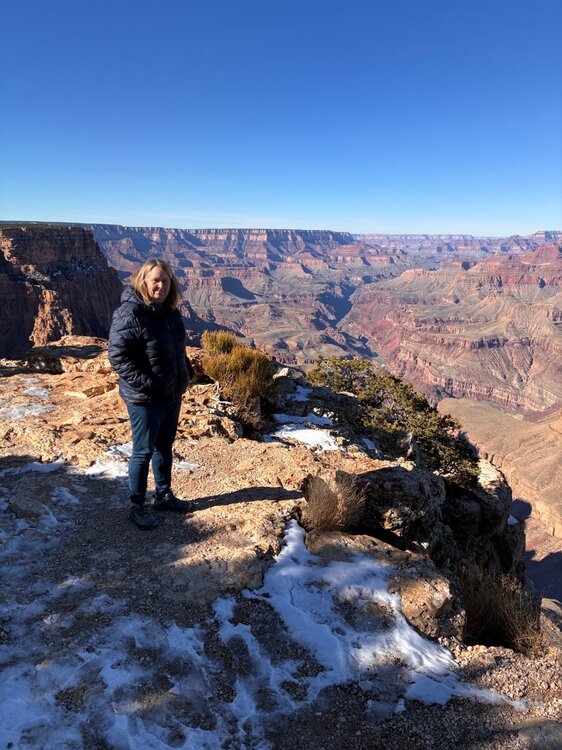-
Posts
245 -
Joined
-
Last visited
-
Days Won
9
Everything posted by taylor.coyote
-
JD and Jason, Vortex must be applied with special equipment by an experienced shop. I got my inspiration from Bugeyed Driver. Vortex is similar to Line-X spray on pick-up bed liner in texture and feel (a firm rubber like finish) I chose Vortex because it is applied at a much lower temperture than Line-X (best not to heat fiberglass too much) and can be painted with automotive paint to match your hull. Bugeyed Driver estimates it increased his tongue weight by 40lbs. The coating is substantial and tough. We have been on the road five 5 week since the application and are pleased to date.. I feel Vortex is a very good solution to protect your trailer nose. Bugeyed Driver has years of experiences with his Vortex..
-
Wow this thing has become confused. It may be my fault due to my minimal electrical skills and not being clear. Below is what we have changed Our transfer switch burned-out. We replaced it. We run shore, generator and 12v DC power in our trailer We do not have an inverter.. We run everything at 12v when not plugged into shore power or generator We replaced the 2016 factory installed progressive dynamic controller that came in the trailer (would not support lithium) with new progressive dynamic controller (PD4045-CSV) to accommodate lithium batteries replaced old AMG batteries with lithium 300AH The new progressive dynamic controller (PD4045-CSV) is charging our lithium batteries to 14.5 volts when the recommended is 14.4volts when at 100%. Per the manufacture's battery techs, our batteries can handle 14.6V max. I'm feeling uncomfotable charging beyond the recommend 14.4V, just below to our battery's max of 14.6 Volts. My question is: For those of you running the progressive dynamic controller (PD4045-CSV) with lithium batteries, how many volts is it charging your batteries when at 100%? You can look at your charging history to see your charging levels at 100% less than 14.4 volts ? 14.4 volts 14.5 volts ? 14.6 volts ? more than 14.6 volts ? At what voltage level do you get a high voltage alarm ?
-
One more issue: put in the new progressive dynamic controller (PD4045-CSV) and its charging my batteries to 14.5 volts.. the recommended for my batteries is 14.4 v. spoke with the battery company techs and they said my batteries top voltage it can handle is 14.6... .. they told me that 14.5 will be ok as long as the control does not change beyond 14.5 v .... what voltage is your PD405-CSV charing your batteries? is my controller opperating as it should?
-
Geoff, found time today for the rear jack. My electrical skills are weak. Wires were off the terminals for the jack. hooked them back, still no action. I took a bonehead approach and installed a new toggle. The result: jack would opperate going up only. I revised the wires and the jack would go down only. Missing the jack fucntion is a small inconvenience. Power issues have been our priority. We resolved power issues today, The jack will have to wait till we are home. thanks..
-
And for the rest of the story: Replaced the converter, replaced the TOASTED transfer switch, replaced AMG batteries (300AH lithium) and added the dork converter for the Maxx fan. JD, after this experience, I'm not ready to let go of the generator redundancy and we need it for the air conditioner. Love to jettison the generator, we'll see now how it goes with lithium batteries. AND AS ALL OF YOU ALREADY KNOW...... YOU CAN'T TAKE IT WITH YOU... AND IT'S ONLY MONEY. Now we are good to go.... almost... while installing the new batteries we discovered broken rivers at the top of the battery box... I found an excellent stream with solutions but this will wait till we get home. We'll keep an eye out but the reduced weight of the Lithium (210 lbs lighter than our AGM batteries). 201 lbs, that's a crazy number. Hopefully lighter batteries will be kinder to the battery box. Thanks to everyone's contributed that has helped get us back on the road.
-
JD, Thank you for your gracious invitation. I would love visit, patch a few loose ends on the trailer and learn from you. Unfortunately Prescott is in our rear view mirror. Assuming we get our power in order, we plan to loop into southern Ut, then New Mexico and find our way home (humboldt county Califroina) by way of San Deigo. Our style is to have a general travel plan with the flexibility to wander as areas interst us. This is our first time in this region. We will return. We would like to recipocate by extending a standing invitation to visit us. We have 8 acres in the redwoods. King and Coho Salmon run in Lindsay creek next our property in the winter. The general area is special and well worth the trip if you have never visited.
-
Thanks for the warning regarding fire and the great diagrams/images. Out of caution we are not attempting to run any power from 30amp sources. We are again heating the trailer with an electric portable heater with short 12 gauge extension cable through dinette window. We have the dinette hatch open to warm plumbing here.. Additionally, we have enough battery to run the trailer heater for a while in the early morning to heat the plumbing on under the passenger side bed. With some luck, our dilemma will over tomorrow. The good news, we did not waste the day. The temp was an amzing sunny 50 degrees on the Grand Canyon south rim. Absolutely fantasitic day. Even better, almost no-one around the canyon. No traffic, empty parking area, empty campgrounds and hotels due to the main water line being shut down for emergency repairs. No water throughout. the park was our private playground today.. a once in a lifetime event. Doesn't get any better than this
-
JD, just got your note... very helpful but I'm down for the night. we have run an extension cord through the window (a little tape to keep to seal the gap) for our portable electric heater. we will be ok for the night. can't believe I have put us in this situation. Camped on the batteries all the way through California thinking all was fine. The tired batteries are my fault but this other stuff at the same time is classic.. you can't make this stuff up. thanks
-
CRM.. thanks for the follow up. I will check the voltage. I found a mobile RV repair guy that seems legit has been helpful way past normal hours. He can get the parts Monday morning with the plan to replace the damaged electronic components. If all goes well, we will be set for shore power and have upgraded everything to be lithium ready. Have not pulled the trigger on the batteries over the phone with the mobile guy. I have made a small bet paying for electronic components up front but not willing part with the cost of batteries until I see the whites of his eyes.
-
Mike and Carol, I posted the above not knowing your post. Thank you. You have given me the information needed. Already checked the master power switch under the bed and all the fuses and breakers under in the kitchen. certain breakers are not the issue. tapping on the transfer relay make the power go on and off..
-
I know the transfer relay is bad. I Tap on it and we get power. I Tap on it again and we loose power. Something is shorting out and or ??? With this symptom, I don't feel it's wise to run shore power. I have been talking with a mobile rv tech about how the rely is behaving. He has seen this issue before and said the box is bad and will only get worse. We still have two possible solutions (besides the extention cord through the window). One is to replace my old AMG batteries. We want to upgrade to lithium if we are going to purchase batteries. Buying lead acid batteries would be a simple solution but not desirable. We know the Victron controller will support lithium but I don't know if the factory converter will or where it is located. Can someone tell me where we can find the converter and possibley the make/model? Does anyone know if the factory converter will support lithium or if the converter will need to be replaced? The other solution is to replace my bad transfer relay so I can have shore power. Ultimately we need to fix all our power issues but one or the other will allow us to continue our trip. At this time I don't know what possible based part availability in Flagstaff or possibly Sedona
-
I have been given some good advice in another stream about batteries. Can anyone tell me where I can find the factor installed converter, the likely brand and model and if it will support lithium batteries? The rest of the story is a nightmare. Camped near the south rim of Grand Canyon ( 7,000 ft) and my AMG batteries are failing and not getting us through the night. We solved the lack of batteries by finding a RV park for shore power. I plug into shore power and NOTHING. We had yet to use shore power on this trip and !@@#@! the transfer relay is not working. So here we are at 7000 ft with batteries not getting us through the night and no shore power. I'm working to either replace my batteries or finding the transfer relay box so we can power to continue our trip. At this point either or is good with us. And of course, it's Saturday night. The stop gap solution: We were able to borrowed (no stores open to buy anything) a 110 power cord to pull through a window to power our electric heater... We are kind of keeping out since of humor. Your help will be apprecaited
-
I am grateful for many things but would like to take this opportunity to tell you how grateful I am for the support of all the Oliver Forum users. We were complete rookie boneheads when we purchased our Oliver but certain we had made a good purchase. The Oliver was a great purchase but a big part of the value has come by surprise by way of this forum. When you are Ignorant, you don't know how ignorant you are. With the support of forum users, we have progressed from rookies to competent Oliver users and learning everyday. This forum has provided us with knowlege to safely drag a 6,000LB projectile around the country, make educated decisions for general maintenance and upgrading our trailer. The User Forum has increased our enjoyment of our Oliver by 50%. When ask about our Oliver, I say we love it but a huge part of the value owning an Oliver is generious support from the Oliver user forum. Let us be the first to wish you the best on however you celebrate the Christmast season. Chris and Tracey
-
Thanks for the feedback. Seems it may be time for lithium batteries. Our four 105AH (200 AH combined usable) AMG's combined with 340W solar panels have provided us with care free power for summer camping. Per Mike and Carol: the idea of 300AH lithium sounds like it would give us carefree power with some headroom going forward. Two questions: I'm thinking our 340W panels may not be able to top off 300AH batteries but will be sufficient to stay ahead of our power needs of 30-40AH per day. Is this assessment is reasonable? Or should we consider adding DC to DC charging from the truck for more charging capacity ? What are your experiences and recommendations regarding the various brands of lithium batteries?
-
We are on an extended trip with weather at or below freezing at night. Our batteries are barely getting us through each night with our normal activities. I'm wondering if it's the cold weather or our four year old AMG batteries are wearing out. We have four AMG 6 volt that provide 200ah usable power. We do not have an inverter and run everything on 12 volts. Out typical routine is charging a couple lap tops, charge a couple of camera batteries, run a dehumidifier (2amps), heat at 60F all night, modest area lighting, refrigerator and a couple hours of Starlink. We start the night at 100%, 12.68 volts and 0 used amp hours. By morning the state of charge is 97-98% with the voltage in the 12.3's and one morning had a 12.2 alarm. This morning our Victron AP showed we had only used 15amp hours since last night's 100% charge. These numbers don't make sense. In the summer, we typically consume 30 +/- amp hours each night without the heater running. We must be burning more than 15amp hours but that's not my question. I don't want to confuse the acruacy of the Victron consumption report with the fact we are within our normal routine + running heat and barely getting through the night. Do you think our batteries are getting tired or is the cold a factor?
-
thanks for sharing. we sleep with the temp at 60F with no issues. The issue is if it's 40F outside, a cold trailer takes at least an hour to get to 65 and I don't think it can get to 70F. The vent under the bed flows at 119 degrees, the kitchen at 99 degrees and the bath 72. We camped two nights ago at 20F. No problem to maintain the desired 60F while we sept but it topped out at 68F when we turned it up in the moring. I have read that 120 -140F is the temperature expected from an RV propane heater. Our heater is adequate but at the bottom of what seems to be expected from an RV heater. I would like to hear about other's heater experience / performance in cold weather.
-
-
Snackchaser, very kind of you to remember me and offer help. As mentioned, we are on the road in AZ. Tomorrow is a short day and don't plan to move for a couple of days. I checked the fuse (looked good) but replaced it anyway. The fuse doesn't appear to be the issue. I had the nose off the trailer a few weeks ago that required unmounting jack's toggles switch. It's a good bet my issue is at or near the toggles. I will access and decide if I want to spend this "adventure time" on the maintenance. I'll let you know. If it's above my skill set, your help would be appreciated. We plan to be home around the first of January.
-
Scuba, found the fuses in-line as you had said about older trailers. Replaced the fuse and still no go. I'll start tracing the connections from the toggle switch back. I have a replacement switch on board. Hopefully a simple task. I'll let you know.
-
Lots written about the furnace but everyone seems generally satified with its ability to warn the cabin living space. We have been in the Anza Borrego area (45-night / 75-day) and headed for colder weather. Even with modified ducting (hard elbows at furnace, hard straight runs passing through the water valve area and cutting 3.5' off in the bath vanity) our heater works hard to get the cabin temperature above 65 degree (starting at 55 degrees inside). We find 65 comfortable but concerned about heating when it's 25 degrees outside. Is this normal? please share your heating experience.
-
Our Experience with the Starlink Mini is the same as Ronbrink. We traveled for many years with an ATT NetGear portable cellular hub but have repalced the NetGear with Starlink. We spend a good part of time off the grid and Starlink provides service everywhere except when you have abstructions such as trees between you and the satellite. The ATT NetGear is great device, it's portable, simple and easy to use. If we didn't spend time off the grid, we would likely stay with the ATT NetGear hub. With an ATT business account our NetGear plan was $65 monthly (+ buying it over time as with cell phones) with unlimited data use.
-
No tv at all in our OLEll. We have Starlink for communication and can get tv content on our laptops if desired.



















